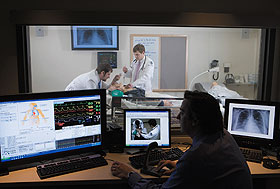Feature Story
Health Center Today, March 5, 2010
Do Real-Life Treatments on Artificial Patient Benefit Medical Students Over the Long Term?
Two UConn Medical Students Conduct Unique Study to Find Out
By Carolyn Pennington

Medical students perform a procedure on SimMan® as Dr. Thomas Nowicki, head of medical simulation at UConn, observes from the control room.
Photo by Lanny Nagler
An advanced patient simulator known as SimMan® has become an integral teaching tool for medical schools across the country. It provides simulation-based education to challenge and test students’ clinical and decision-making skills during realistic patient care scenarios.
“Simulation based education is becoming an important part of medical training and we are working to introduce it at all levels throughout the medical school experience at the University of Connecticut,” says Dr. Thomas Nowicki, emergency room physician and director of medical simulation at UConn.
It’s been assumed that SimMan® enhances what students learn in the classroom and helps them better retain the information. But when fourth-year School of Medicine students Jason Kurtzman and Christopher Sala began researching SimMan® for their scholarly project, they found very little data to support that assertion.
“The real point of our research is to show there is a justification in buying these 30 to 75 thousand dollar mannequins,” says Kurtzman. “Everyone says it must be that with the hands-on experience you remember it better but no one has actually proven it with numbers that it actually does enhance learning ….not for medical school students anyway.”
So Kurtzman and Sala, both of whom are interested in emergency medicine, enlisted a group of 11 second-year medical students who were taking the emergency medicine elective or were interested in emergency medicine. The students were given a pretest to assess how well they knew the subject of chest trauma. Then Kurtzman and Sala co-taught a lecture about chest trauma that was appropriate for second-year medical students. They then split the participants randomly into two groups. One group stayed in the classroom and studied written patient cases from a textbook.
The second group went to the simulation lab in the Clinical Skills Assessment Department and reviewed the same patient cases but used SimMan® to demonstrate the symptoms and treatment.
“So the same presentation was given to them but all the labs and the vitals were given on the monitors in real time and they had to interact with the SimMan® as a patient would be presenting to them in the ED,” says Sala. “After they went through and tried to figure out what to do—that whole group talked it through on what should have been done.”
Afterward, all the students came together again and took a post-test to assess how much they learned. Those results were then compared to test results taken three months later. Sala says “The test was basically the same—slightly different wording—but basically the same questions so we could determine which group retained the knowledge better.”
So what were the long-term results? They found the classroom group did better than the Sim group, though the numbers were not statistically significant. “And there were some confounding factors that may have skewed the results, such as the fact that there are more EMT-trained students in the classroom group,” says Kurtzman.
“Since the group was small, it’s tough to come out with really hard data,” explains Sala. “This is just the beginning, though. Other medical students have already expressed interest in doing a follow-up next year for their selective project and they can learn from our study and adjust for the confounding factors that we experienced this year.” And as more data is collected, a truer assessment of SimMan®’s long-term impact on learning retention will be gained.
“The students have really taken a strong interest in simulation medicine and I am pleased to see they are taking it to the next step and researching its efficacy,” adds Nowicki.


